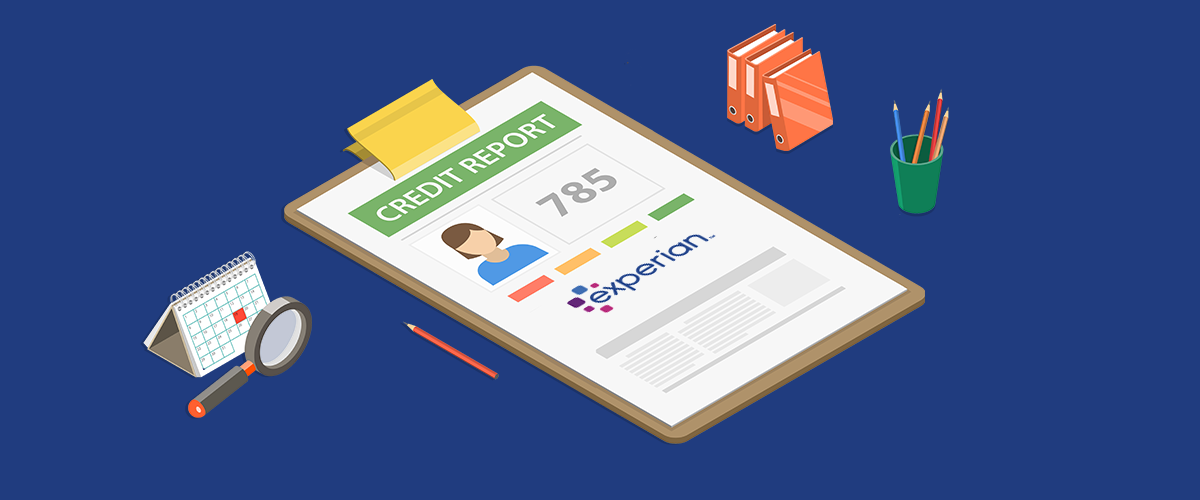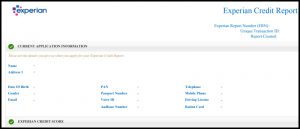Blogs > All About Experian Credit Report

Staying on top of your finances is the first step towards financial well-being. In order to do the same, it is vital to check your credit report on a regular basis. A credit report helps you to assess your financial standing and helps you manage your finances better. Therefore, it could be a big mistake for your financial well-being.
Experian Credit Information Company of India Private Ltd. is a popular credit bureau in India. It provides credit reports to its customers stating their credit history. This, therefore, helps them assess their creditworthiness over the time. As a result, the credit bureau keeps updating its algorithms to provide more accuracy. Hence, the information seen on your credit report could become daunting if you don’t understand it.
Parameters |
Experian |
Year of establishment |
2006, the license granted in 2010 |
Cost of credit report and credit score |
₹399 including taxes(Credit report + Credit score) |
Scoring system |
300-900 where 900 is the perfect credit score |
Time taken to generate the report |
20 days |
The Experian credit report contains all the information about the individual’s credit history. In addition, this includes the track records of your loans, credit cards, and others. As a result, this category is divided into the following categories:
— Current Application Information
— Experian Credit Score
— Report Summary
— Summary: Credit Account Information
— Credit Account Information Details
— Credit Inquiries
— Non-Credit Inquiries
The category of current application information includes all the personal information of the applicant. Additionally, the details are given when the individual applies for an Experian Credit report. This includes:
→ Applicant’s Name
→ Address
→ Date of Birth
→ Gender
→ Email
→ PAN
→ Passport Number
→ Voter ID
→ Aadhaar Number
→ Telephone
→ Mobile Number
→ Driving License

The next category includes the credit score provided given by Experian based on various factors. The factors considered to evaluate your Experian credit score are:
→ Recency: Recency includes all the recent defaults in the credit accounts
→ Leverage: It includes all the credit accounts that have a history with on-time repayment
→ Coverage: Non-delinquent and delinquent credit accounts
→ Delinquency Status: Defaults on Credit Accounts( current & recent intervals)
→ Credit Applications: Any inquiries made over the last 30 days

The category of report summary includes details of your credit accounts. Hence, this includes your total credit accounts, current balance accounts, summaries of your credit enquiries and non-credit enquiries. The sub-categories of report summary are:
⇒ Credit Account Summary
— Total Number of Accounts: This includes the total number of accounts you have or had since your credit report was built.
→ Active Accounts: That being said, the accounts that are currently existent
→ Closed Accounts: The accounts that were closed by paying in full
→ SF/WD/WO/Settled: The number of the accounts that have been marked as Suit Filed/Wilful Default/ Written Off/ Settled.
⇒ Current Balance Amount Summary: The section contains the total balance outstanding in the following categories:
→ Total Current Balance Amount
→ SF/WD/WO/Settled Amount
→ Secured Accounts Amount
→ Unsecured Accounts Amount
⇒ Credit Enquiry Summary: The enquiries made by the individual to any lender in the last 180 days are divided into the following categories:
→ Last 7 days credit enquiries
→ Last 30 days credit enquiries
→ Previous 90 days credit enquiries
→ Last 180 days credit enquiries
⇒ Non-Credit Enquiry Summary: The enquiries made by the individual, not for the purpose of credit are divided into the following categories:
→ Last 7 days non-credit enquiries
→ Previous 30 days credit enquiries
→ Last 90 days credit enquiries
→ Previous 180 days credit enquiries

This section displays the summary of all your reported credit accounts found in the Experian Credit Bureau database. It gives you the following information about each account:
→ Lender: Name of the lender
→ Account Type: Credit card, overdraft, home loan, etc.
→ Account No: The unique account number
→ Ownership: The ownership of the account if it is individual or joint
→ Date Reported: The date it has been reported
→ Account Status: The status of whether the account is active/closed/settled/written-off
→ Date opened: The date the account was opened
→ Sanction Amount/Highest Credit: The credit limit of your account
→ Current Balance: The balance that is currently outstanding
→ Amount Overdue: Any amount that is overdue

This section has information based on the details provided to Experian. by all the member banks, credit/financial institutions and other credit grantors with whom the individual has a credit/loan account.
The sub-categories that fall under this category are:
1. Credit Account details
Account Terms
→ Account Number
→ Date Opened
→ Date Closed
→ Ownership
→ Rate of Interest
→ Value of Collateral
→ Type of Collateral
→ Suit Filed/Wilful Default/ Written off status
Account description
→ Date Reported
→ Loan Type
→ Account Status
→ Highest Credit
→ Current Balance
→ Amount Overdue
→ Last Payment Date
→ Suit Filed/ Wilful Default
Account Details
→ Credit Limit Amount
→ EMI
→ Repayment Tenure
→ Total Write-Off Amount
→ Principal Write-Off
→ Settlement Amount
→ Written Off Settled Status
The payment history shows a table of your track record payments for the last years. Furthermore, the table shows the DPD or Days Past Due.
The Days past due are the number of days that have passed since the agreed payment due date of EMI. As a result, the table can have different letters that mean differently.
Indicator |
Meaning |
Explanation |
|
0
|
Up-to-date | This means the payments are made within the agreed payment due date |
|
>0 |
Overdue by the respective number of days | This number indicates the number of days past due reported by the lender |
|
S |
Standard | An account which is overdue for less than 90 days |
|
B |
Substandard | An account which is overdue by more than 90 days but less than 12 months. |
|
M |
Special Mention | The accounts are standard but for some reason are monitored closely for any discrepancy |
|
L |
Loss | An account where loss has been identified but has not been written off, wholly or partially |
|
D |
Doubtful | An account which is overdue by 90 days for more than 12 months
|
It includes the information provided by the individual to the lender. This includes the date of birth, gender, occupation, email address, phone number and ID information.

As the name suggests, this section shows the names of the credit institutions that have processed a credit/loan application for you. Moreover, the searches stay on the credit report for 12 months. That being said, this category includes the following information:
→ ERN
→ Search type
→ Credit Institution Name
→ Application date
→ Amount applied for
→ Duration of agreement
This consists of authentication requests and requests for your Experian Credit Report by you. Hence, the non-credit enquiries include the following pieces of information:
→ ERN
→ Search type
→ Credit Institution Name
→ Application date
→ Amount applied for
→ Duration of the agreement
Related Article: Hard and Soft Credit Inquiries | What’s The Difference?
1. The Experian credit report is sent on your registered email address. Hence, to open the file, you need an Adobe Acrobat Reader.
2. In addition to that, the email contains a Unique Transaction ID number that is mentioned in the body of the email.
3. The password of the file consists of the first 4 letters of your first name followed by the date and month of birth (in DDMMM format), then followed by the Unique Transaction Number.
4. For example, if the name in the account is Tejas Kumar, the date of birth is 04-07-1970 and the Unique Transaction Number is 1234567, then your password will be TEJA04JUL1234567.
5. If you see any kind of discrepancy, you must inform the lender and the credit bureau.
All in all, you should always check your credit report to assess your financial standing. At IndiaLends, get your credit report worth ₹1200 for free. IndiaLends is a digital lending and borrowing marketplace that provides best credit products as per your requirements.
To know more about us, you can visit our website here.